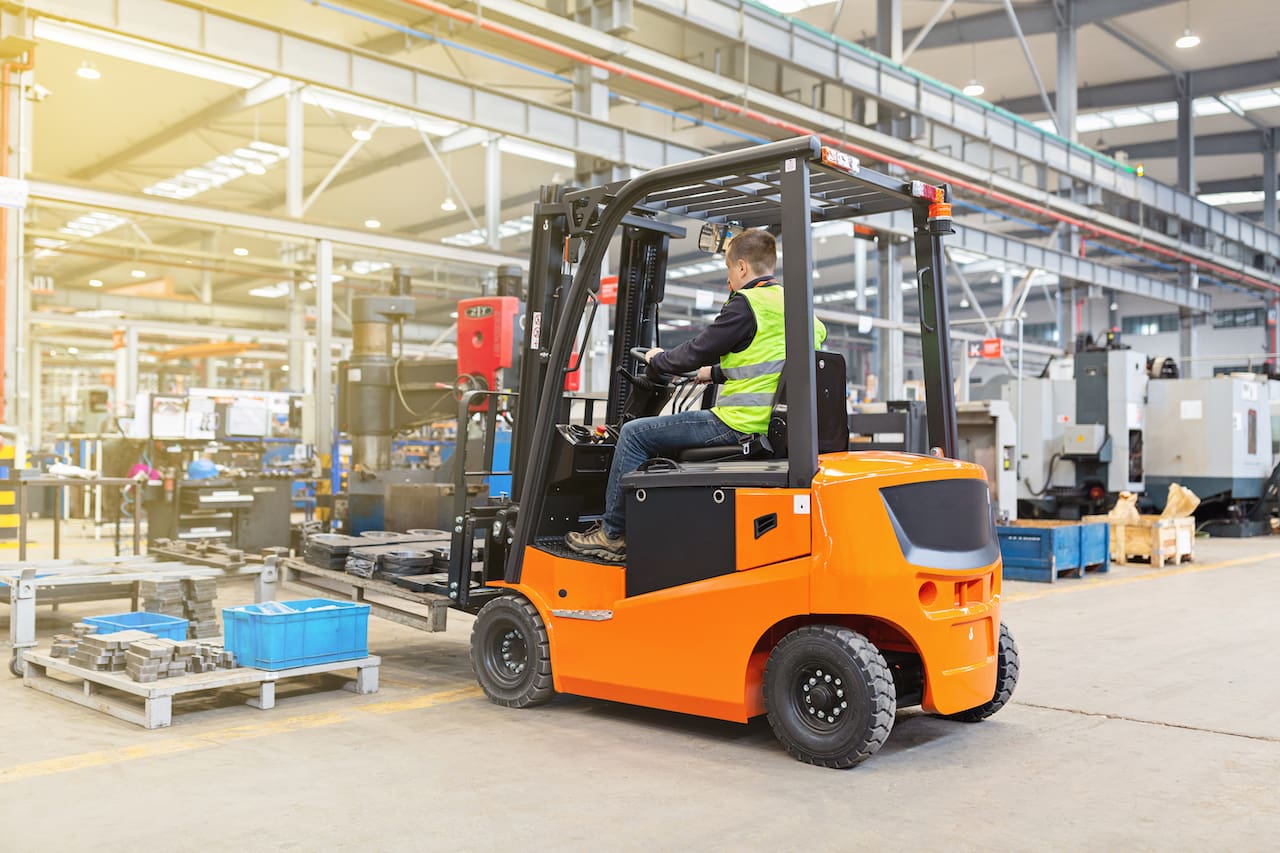Table of Contents
** Minutes
What is warehouse material handling?
Types of warehouse material handling equipment and activities
The importance of warehouse layout in material handling
Optimizing warehouse material handling for ecommerce fulfillment
Top metrics to track in warehouse material handling
Best practices and tips for unavoidable manual material handling processes
Common material handling mistakes to avoid in a warehouse
Warehouse material handling’s role in supply chain optimization
Adapting warehouse material handling to meet changing market demands
How ShipBob’s tech-enabled fulfillment services support efficient warehouse material handling
In an ecommerce warehouse, things are moving all the time – literally. Finished products and raw materials go on quite the physical journey before they are packed in orders, changing hands many times and traveling through multiple warehouse stations or locations.
How those materials are physically moved is a key to a safe, speedy, and efficient warehousing operation. If materials are handled in the proper ways and using the proper equipment, it’s much easier to keep normal processes running smoothly. But if your warehouse material handling is sloppy or hazardous, it can impact warehouse efficiency and productivity.
In this article, we’ll dive deep into warehouse material handling and the role it plays in your ecommerce supply chain. We’ll share best practices, common pitfalls to avoid, and how you can optimize the process to improve your ecommerce fulfillment.
What is warehouse material handling?
Warehouse material handling refers to the movement, storage, protection, and control of materials throughout the supply chain.
Any time materials in a warehouse (such as raw materials or finished inventory) are physically moved – including during manufacturing, procurement, receiving, storage, fulfillment, shipping, and last-mile delivery – warehouse material handling is involved.
Proper warehouse material handling ensures that raw materials and products are carefully and efficiently transported where they need to go, so that a business can speed up its supply chain, minimize errors, and reduce waste.
“If someone is going to treat your products like their own, that’s the most you can hope for in a fulfillment partner. ShipBob does exactly that.
The customer experience and brand consistency is really important to us, so to receive that level of support from ShipBob means so much to us.
Because we don’t operate our own warehouse and fulfillment centers, we need to trust a 3PL team that is going to be invested in delivering our products to the best of their ability.”
Stephanie Lee, COO at PetLab
Types of warehouse material handling equipment and activities
Equipment is almost always necessary to move materials in a warehouse. There are several different types of material handling equipment, each of which supports different activities in your warehouse.
Manual material handling methods and tools
Even if you’re moving materials by hand, you still may need tools to help you do it. Manual material handling tools are solely operated by humans, are relatively simple in design, and don’t involve digital or electric technology.
These tools are extremely versatile, and can be used across many different warehousing functions. Pallet jacks, for example, help to ease the movement of pallets from one place to another, which can be useful in loading and unloading operations as well as general transportation of goods.
Similarly, picking carts help workers to store and transport retrieved items to their next location. Lift tables can help ensure better ergonomics during order preparation, and hand trucks are used to easily transport boxes and unpalletized loads within the warehouse.
Motorized material handling equipment
Depending on the size of the warehouse, you may also find motor-driven material handling equipment that is operated by humans. These help workers move large, heavy, or numerous materials efficiently and safely, and can even help prevent injuries.
For example, motorized height adjustable carts have been known to significantly reduce the risk of injuries, as workers don’t have to lift heavy boxes above their heads and risk straining themselves or losing their grip and getting hurt.
Counterbalanced forklifts are also commonly used in the loading, stacking, and transport processes. You may also find narrow aisle forklifts that are specifically designed to be used in warehouses with limited space. Additionally, motorized order pickers can assist workers to retrieve items during the picking process.
Automatic material handling equipment
Some warehouses use automated material handling equipment that’s operated by a warehouse control system. The control system determines how the machines should move and what they need to do.
Conveyor belts or conveyor systems are a common type of automatic material handling equipment, which move materials quickly and easily between different locations in the warehouse. Automatic guided vehicles, stacker cranes, and autonomous robotic delivery systems can also save time and streamline warehousing processes.
Choosing the right equipment for your business
Whether your business should use manual, motorized, or automatic equipment (or a mix of some or all) depends on the unique needs of your business, and the layout of your warehouse.
For example, if you have a large warehouse with plenty of vertical storage, you will likely need motorized or automatic material handling equipment to move materials quickly across great distances, and safely take down heavy boxes of inventory stored on high pallet racks. If your warehouse is relatively small and your products are light, you may be able to rely solely on manual equipment.
Once you assess your needs, inspect your existing warehouse operations to see what you could improve, and consider what type of equipment could make those improvements. For example, are you relying on manual tools that can slow down your operations and risk worker injury? If so, your operations may benefit from motorized or automatic equipment.
You’ll also need to look at your current warehouse technologies and warehouse control system before introducing any new material handling tools. Make sure any new equipment you invest in can seamlessly integrate with your existing systems, so that there are no disruptions in your workflows.
Above all, any equipment you decide to add to your material handling operations should improve workers’ safety, rather than hinder it. If a piece of equipment is causing confusion or creating hazards for employees, it is not the right choice for your brand and should not be used on your warehouse floor.
The importance of warehouse layout in material handling
How your warehouse is laid out also impacts your material handling. When a warehouse is organized clearly, it not only helps you maximize the available space, but also makes it much easier to transport materials where they need to go. This means less risk of materials getting lost or damaged, less risk of disruptions and safety hazards, and a quicker, more streamlined moving process overall.
When designing your warehouse layout, be sure to:
- Keep aisles wide enough for any equipment you have, for workers to navigate safely, and for a two-way flow of traffic.
- Store products that are commonly ordered together nearby each other to minimize the distance pickers must travel.
- Store popular materials in easy-to-reach places to avoid delays.
- Have distinct stations for different functions (i.e., cross-docking, receiving, picking, packing, etc.), so workers don’t get confused.
- Designate and label storage places forever SKU or material, so workers can move materials to the correct location quickly and easily.
Optimizing warehouse material handling for ecommerce fulfillment
Even if your warehouse material handling is decent, there are usually many opportunities for improvement – particularly when it comes to ecommerce fulfillment. Optimizing your material handling is an easy way to boost your order accuracy, minimize lead times, and deliver a better customer experience.
You can start optimizing your warehouse material handling by:
- Replacing old equipment with new, automated tools
- Investing in a more powerful digital warehousing solution such as a warehouse control system or warehouse management system (WMS)
- Leveraging automated pick list generation software that determines the most efficient picking route for workers
- Using barcodes and barcode scanners to make sure inventory is stored in the correct locations, and the correct SKU is picked every time
- Calculating each product’s dimensional weight and selecting optimal packaging, so that items are not damaged in last-mile transit
Top metrics to track in warehouse material handling
To know for sure that your efforts to optimize your material handling are paying off, you’ll need to track certain warehouse KPIs. Here are some of the most important metrics related to warehouse material handling that you should follow over time.
Maintenance costs
First, look at how much you’re spending on equipment maintenance. Are there any pieces of equipment that seem to rack up maintenance costs more than usual? If so, there might be a need to replace some of your older material handling equipment if you’re overspending on maintaining them.
Equipment utilization rates
How often and how effectively you use your tools is another indicator of how well your existing equipment is supporting your operations. By tracking use and results over time, you get insight into how each piece of equipment helps or hurts material handling. For example, perhaps you notice that forklifts actually slow your operations, and thus may need to be replaced with something a bit more functional.
Picking accuracy
Warehouse picking activities constitute a significant portion of the material handling process, so it’s important to monitor your picking accuracy to see how often materials and goods are being picked correctly. If your picking process is prone to error, you may need to rethink your material handling strategy.
“Before we implemented ShipBob’s WMS, our order accuracy rate was around 92%. Now we’re at 99.7% for order accuracy, which equates to 2,100 less mispicks a year on average. ShipBob’s system for picking orders has cut down on labor costs, reduced lost inventory, and eliminated the need for double shipping. That’s been huge for us.
Our order picking and routing has also greatly improved with ShipBob. With the ShipBob WMS, we can create the most efficient routes through the warehouse, which has cut down on an insane amount of time and made picking, packing, and shipping so much more efficient.”
Jourdan Davis, Operations Manager at Pit Viper
Productivity
If your material handling is improving, your warehouse productivity should also go up. Streamlining material handling processes enables workers to complete their assigned tasks more quickly and easily, meaning they are able to get more done in the same amount of time.
By tracking productivity-related metrics such as average time to pick an order, order cycle time, put-away time, and so on, you will be able to measure warehouse efficiency and material handling’s impact.
Best practices and tips for unavoidable manual material handling processes
While a lot of material handling processes can be automated, there may be some aspects that require a human touch. Here are a few tips for increasing efficiency when manually moving materials or products.
Safety
Accidents are not only harmful for workers, but can also cause significant delays, backlogs, and worker shortages in your material handling process. As such, it’s crucial to prioritize warehouse safety by using the right equipment, cleaning your warehouse floor space regularly, and keeping storage and stations organized.
Training
To avoid creating hazards and breaking equipment, make sure that your team members are properly trained on every piece of equipment they will need to use in their role.
You should also train staff on your safety protocols and SOPs, as well as any tribal knowledge specific to your warehousing operation. With thorough training and warehouse labor management, employees can know exactly what they’re supposed to do, and how to do so in a safe and efficient manner.
Supervision
Even when you trust your team, supervision is still necessary in a warehouse. Managers and directors ensure that processes and functions are working as they should, and that materials are handled appropriately. Supervision also helps support workers, so that they can quickly receive assistance when needed.
Common material handling mistakes to avoid in a warehouse
As they optimize warehouse material handling, many brands end up making the same mistakes. Here are some of the most common – and avoidable – mistakes that reduce the efficiency of material handling.
Lack of equipment upkeep
If you’re not regularly auditing your equipment and warehouse storage systems and performing routine maintenance, you could risk experiencing expensive accidents or shutdowns in the future. For example, if your warehouse racks are not checked or repaired on time, they could give out at some point and result in expensive inventory damage as well as worker injury.
Lack of inspections
When warehouse inspections and audits are not performed regularly, you may not be able to catch safety issues before they cause problems. Even if inspections temporarily disrupt workflows, performing them is not only necessary, but will help you prevent even bigger and more costly disruptions in the future.
Inadequate warehouse layout
The limited warehouse space may not be within your control, but there are ways to maximize capacity with the right layout and shelving systems. Make sure to take time to optimize your warehouse layout and space utilization, so that your materials stay organized and easily accessible even as your brand grows, order volume increases, and operations pick up speed.
Inadequate planning and training
Failure to properly train your staff on how to perform their assigned tasks opens your brand up to accidents, errors, delays, and backlogs. However, when staff are trained how to properly navigate the warehouse, operate equipment, and perform their tasks, material handling is much more efficient.
Warehouse material handling’s role in supply chain optimization
A functional ecommerce supply chain depends on materials moving through a warehouse quickly and efficiently. If materials take too long to be transported from one phase or location to another, it will slow down all operations (including inventory receiving and storage, order fulfillment, and shipping). This means that as orders can’t get fulfilled as quickly, prolonging lead times for customers and ultimately resulting in a worse delivery experience.
That said, to avoid bottlenecks in your supply chain, you will need to focus on improving your material handling process. Streamlined warehouse material handling enables products and materials to move seamlessly from receiving to storage to picking bins to packing stations, which in turn helps workers perform tasks more easily. In essence, good warehouse material handling greases the gears of a brand’s supply chain, and improves the efficiency of every other function.
Adapting warehouse material handling to meet changing market demands
The COVID-19 pandemic disrupted nearly every warehousing activity – and warehouse material handling was no exception.
On a micro-level, material handling in individual warehouses slowed due to implementing necessary COVID safety protocols. Warehouse workers had to stay 6 feet apart, sanitize high-touch surfaces like material handling equipment regularly, and stop what they were doing to use hand sanitizer.
At the same time, ecommerce brands were experiencing unprecedented levels of demand, which also put pressure on material handling procedures. It was difficult to get materials due to freight blockages and labor shortages, which only compounded delays.
While the pandemic’s aftershocks are beginning to subside for the ecommerce industry, it revealed how fragile many material handling operations were. As a result, many brands have made major changes to future-proof and scale material handling systems.
For example, many brands are looking for more streamlined, reliable ways to move freight inventory from manufacturers to their warehouses, so they have products available to sell to customers when demand is high.
After replenishment inventory was tied up for months in port blockages, some brands are utilizing freight solutions such as ShipBob’s managed freight program to get materials from China to the US faster and most cost-effectively.
Others are doubling down on demand forecasting, in hopes that more accurate forecasts will help them avoid stockouts in the future and properly allocate materials and products across their distribution center network.
But if the pandemic underscored one focus area, it was scale. Businesses need material handling processes that are adaptable enough to meet consumer needs, and that can be scaled up or down flexibly maintaining efficiency and accuracy.
For this reason, automated material handling equipment and smart warehousing technologies are quickly becoming warehousing staples – so much so that the market for automated material handling equipment reached 32 billion in 2020.
Automated systems help to streamline and speed up the process while reducing the risk of injuries, while warehouse control systems and other equipment can be used to minimize the need for manual work and easily transport goods from one point to another.
As a result, you can significantly speed up your warehousing and fulfillment processes as workers can focus on tasks that require human involvement. They may also make use of various technologies to further improve the efficiency of their operations. For example, automated storage and retrieval systems can be used to improve precision and speed in the order picking process.
How ShipBob’s tech-enabled fulfillment services support efficient warehouse material handling
Warehouse material handling can take a long time to master. If your brand is looking to optimize how inventory moves throughout your warehouse and your supply chain, outsourcing fulfillment to a tech-enabled 3PL like ShipBob can help you do so in no time.
ShipBob provides outsourced fulfillment solutions so you can offload your material handling to professionals. That way, you’ll be able to improve productivity, efficiency, and accuracy rates without you having to manage inventory receiving, storage, picking, packing, or shipping yourself.
If you’d rather keep material handling in-house, you can also use ShipBob’s proprietary warehouse management system (or WMS) in your own warehouse. Our WMS gives you increased visibility into your warehousing operations so you can easily track productivity, ramp up new staff, and improve efficiency. It gives you better control over inventory movement in your warehouse by providing location-specific visibility and real-time inventory tracking.
“ShipBob is a global fulfillment platform that wrote its own software instead of using someone else’s, and uses it to run their own outsourced fulfillment service. That was definitely a solution we could trust, and the solution we wanted. ShipBob’s WMS has turned out to be exactly what I hoped it would be. They have built a really robust software system that does a fantastic job at running warehousing and fulfillment operations.
I’ve also been super impressed with the system’s efficiency. I think a lot of that has to do with how the picking algorithms are built, and how the software groups and clusters like-items to streamline the process. The stowing process can be super simple, and ShipBob’s WMS still lets us pick and pack at least ten times faster than before.”
Ben Tietje, Co-Founder and CEO of Earthley
To discover how ShipBob can make material handling easier for your brand, click the button below to speak with an expert.
Warehouse material handling FAQs
Below are answers to common questions about warehouse material handling.
How can businesses determine the right balance between manual and automated material handling processes in their warehouses?
Businesses can look at productivity metrics, equipment utilization, and accuracy rates over time to determine whether their operations would benefit from manual handling processes, automated handling processes, or a combination of both.
Are there any warehouse material handling trends or innovations that businesses should be aware of in order to stay competitive?
To stay competitive, businesses should keep track of automated material handling technologies as they continue to develop, as well as strategies for optimizing warehouse layouts.
How can warehouse management systems help improve material handling efficiency and accuracy?
Warehouse management systems can provide better visibility into warehouse operations, increased inventory control, and improved labor management, which will eventually improve the efficiency and accuracy of material handling.



